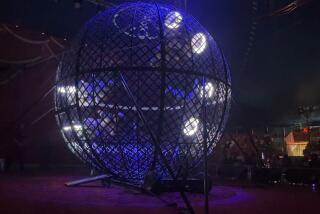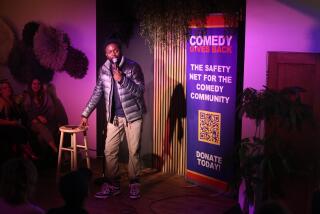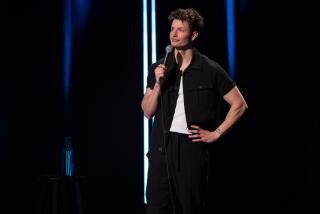Silliness Is Serious Stuff at Clown College : Circus: Would-be clowns apply from all walks of life but only 35 of about 4,000 applicants nationwide are chosen.
They work for peanuts, jump through hoops for customers, take abuse from fellow employees and laugh about it. On the road 11 months a year, theyâre lulled to sleep by a trainâs metallic click and sway. Ah, the life of a circus clown.
Itâs no picnic.
Yet dreamers, free spirits and lost souls still aspire to the Big Shoes, red rubber noses, baggy pants and a spot under the big top.
Who are all these would-be clowns, anyway?
Several turned up at the Long Beach Arena recently to audition for the Ringling Bros. and Barnum & Bailey Circus Clown College, a tuition-free, 10-week training program in Florida. (Other auditions will be held Aug. 1 at the L.A. Sports Arena and Aug. 8 at the Anaheim Convention Center.)
These particular candidates were all male, from age 17--the minimum required--to 33. What did they have in common, besides circus fever? Not much.
There was Syd Schultz, 27, a stocky cruise line security director with a military haircut and muscles that tested the limits of his blue shirt. Schultz described himself as âthe neighborhood clown.â Who would argue?
Joseph Bustard, 33, whose worn-out jeans and lined face attested to hard times, had worked âas a cook, house painter, gardener. I always wanted to run away and join the carnival.â
It was between shows; technicians were setting up for the next performance, two hours away. Concessionaires were readying their wares. The air was redolent of popcorn and elephant.
The applicants quietly gathered in the arena among a maze of cables, wires and ladders. Trapeze bars and hoops were tethered overhead. Clowns in full makeup had the men fill out forms, then snapped their pictures. A lady clown--Pinocchio-nosed, blue-wigged Jill Jeffrey--readied the video camera.
First there were warm-up stretches--and a near-audible groaning of hamstrings. Then came mood exercises. The group was asked to look happy, sad, angry and shy. Make it big, they were told; the last row has to see it. The ice was broken; most of the candidates grimaced and grinned hugely, watched intently by the pros.
Three of the real clowns then demonstrated âThe Mannequin Gag,â a typical routine involving a stiff-limbed dummy (Jeffrey) and two bickering decorators (Ted Ferlo and Dave Dedera). Then the applicants had to show their stuff.
They were taught a slapstick bit about two sillies who meet in the park. Pairing off, they practiced double-takes, gestures and chases. Then they performed for the pros, pair by pair. All were game; a few had it down pat.
The session wrapped up with taped interviews. The video and the surprisingly tough and personal application forms will be sent to Clown College director Steve Smith. Out of an estimated 4,000 applicants, only 35 will be chosen for the class of â92. How does Smith separate real clowns from clown wanna-bes?
âThe determining factor is not just talent,â Smith said, âbut also the group dynamic. Iâm going to take 35 people and lock them in a pressure cooker and turn up the heat each week; I want to make sure that no one is going to go ballistic on me.â
Silliness is serious business.
Smith described the program as âboot camp . . . not summer camp. Our day starts at 8 a.m. and goes to 10 p.m., six days a week. We teach everything from acrobatics to gymnastics, juggling, unicycle riding, how you slip on a banana peel without breaking your neck, how to throw a pie.
âWe study the films of Buster Keaton, Chaplin, Laurel and Hardy. . . . We have lectures on the history of the circus, the history of clowning; we touch on crowd psychology, child psychology: how to sensitize a clown who is garish and big to approach a 3-year-old--you must tone it way down so you donât scare the kids to death.â
Students are not guaranteed a job with the circus. Only âabout a third of each yearâs classâ ends up being hired. âThis is like undergraduate school,â Smith said. âThe circus is the graduate program that teaches you other things--like how to adapt to living on trains and what itâs like living with lions and tigers and bears, oh, my.
âAnd there is lots of âOh, my.â â
Bill Irwin, class of â74, is perhaps the most illustrious Clown College alumnus. The avant-garde clown extraordinaire is ranked by critics with great clowns of the past--Chaplin and Keaton. He was the first performer to be awarded a $176,000 MacArthur Foundation âgenius award.â His acclaimed theater piece, âThe Regard of Flight,â can be seen at the La Jolla Playhouse.
The Clown College gave Irwin âexactly the physical information that I wanted,â he said. âFalling down, illusions with costumes, structures of routine. We went home very tired and sore at the end of each day, but it was an exciting time. Even around the motel where we were put up, after hours you still wanted to practice--there would be people in the parking lot working.â
After the applicants left--reluctantly--Jay Stewart, 26, a Pierrot-style clown in whiteface, talked about the group, as technicians shouted back and forth across the arena and heavy mats crashed down on the floor with a sound like gunfire. The audience for that eveningâs show was just beginning to trickle in, carrying souvenirs, cotton candy and soft drinks.
âI thought there were a few who definitely were deserving of wearing the Big Shoes,â Stewart said. âWe donât like to put just anybody in these--âhe held up one enormous, pancake-like foot--âyou gotta earn it.â


